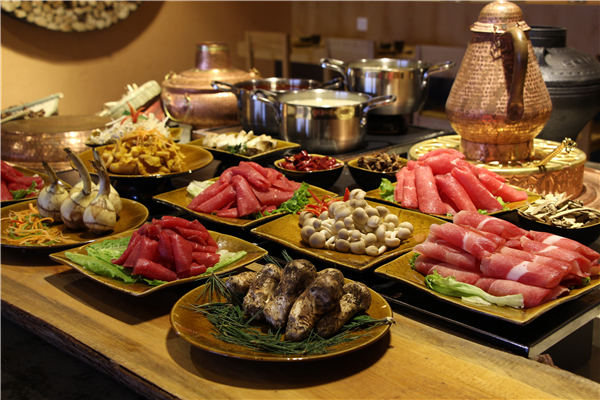Pigs of paradise at Shangri-La restaurant
 |
|
Ingredients include locally grown mushrooms for a hotpot. |
Launched in August, Hylandia by Shangri-La is deemed an important milestone for the Hong-Kong hospitality group, as Shangri-La, the city, is popularly believed to be the physical inspiration of the earthly paradise depicted by James Hilton in Lost Horizon, from which the hotel group takes its name.
While it has taken the group seven years of effort to build a hotel for modern-day explorers to "discover their own slices of paradise", chef Wu says his own job-to offer a bite of heavenly cuisine-has just begun.
He begins from pigs, or more precisely, Tibetan fragrant pigs.
A Tibetan fragrant pig, as the locals define it, has fed on wild nuts and snow-melt water. Trim from trotting around every day at an altitude up to 4,000 meters, it should be no heavier than 75 kilograms. It is believed to be an accidental hybrid from male wild boars in the primeval forests and female domestic pigs tended long ago by hunger-stricken Tibetans, who attempted to catch wild boars to fancy up their meals by having their female farm animals seduce them.
The pig doesn't really give off a more pleasant smell than its flatland folks-not when alive.
"Many people shun pork because of the greasy and guilty fatness, but the Tibetan pig has the perfect proportion of fat and lean meat for roasting," says Wu.
He discovered the meat during a lunch with a Tibetan family while doing his field research about local cuisine.
Hidden in northwest Yunnan's Diqing Tibetan autonomous prefecture, Shangri-La enjoys a unique geographical location that borders Sichuan, Tibet and Yunnan. As a result, the local cuisine is known for its combination of flavors from the three areas.
For example, Wu's Tibetan pigs are marinated in 18 different Sichuan spices and herbs for five hours, and then roasted on charcoal made of three types of wood from Yunnan, the most forested province in China.


















